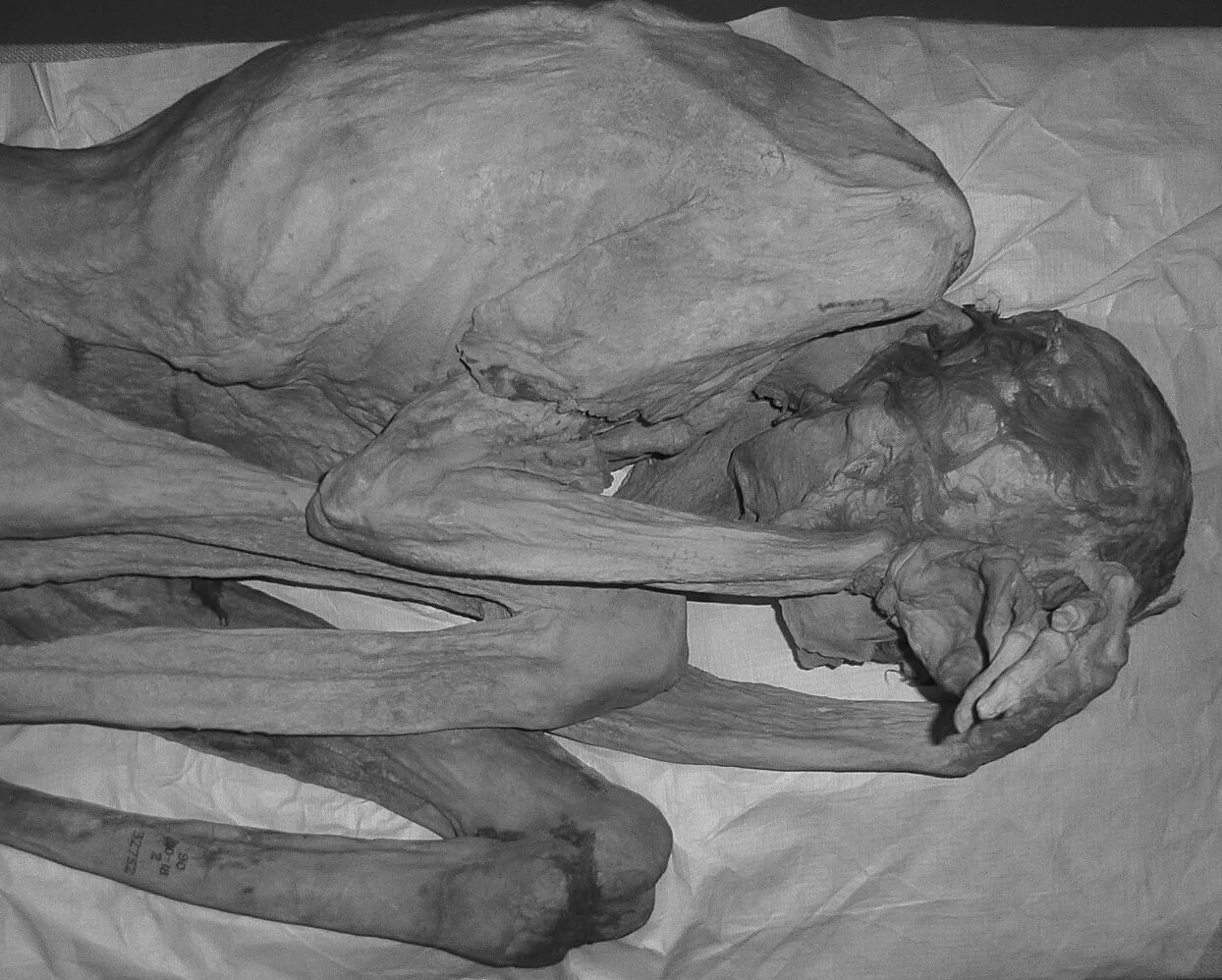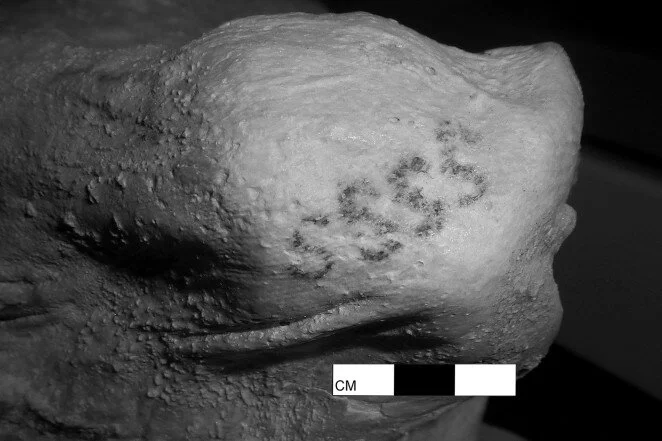The Oldest Tattoos Recorded
Let’s chat about the oldest known tattoos. In the blog post previous to this one, we discussed Otzi The Iceman. An ice mummy from the Alps with 57 tattoos that are theorized to be early examples of acupuncture, and the first evidence of applying permanent pigment to the skin with incisions.
While Otzi holds the title of oldest tattoo, the Gebelein Mummies get recognition for having the first recorded tattoos with animal images and designs. The difference here is Otzi’s tattoos are theorized to be medicinal rather that aesthetic adornments like the latter. I would like to emphasize, however, that our current day understanding of tattoos is the lens through which we analyze tattoos of the past, even if we come from that culture. We cannot time travel back to these cultures and places, most of what we have left from ancient times are the trash people left behind. Seriously! Archaeologists are in a sense, time traveling dumpster divers, and I say that with love.
Today’s tattoo collectors, a female and a male, passed 5,000 years ago. Archaeologists originally called the man “Ginger” due to his red hair, but after the Human Tissue Act of 2004’s policy on naming human remains, the nickname was dropped and he is officially known as the “Gebelein Man”. The female is referred to as the “Gebelein Woman” and they are collectively known as the “Gebelein Mummies”. The two were re-discovered among other graves in the predynastic (6000-3150 BCE) site of Gebelein in Upper Egypt, where burials most often took place outside in shallow graves filled with grave-goods. The hot, dry sand the two mummies were buried in naturally mummified them. This natural process preserved them better than the succeeding deliberate mummification and embalming practices Egypt is now known for.
Gebelein Man
Since Gebelein Man was preserved so well, archaeologists were able to determine details about his life and death not usually discernible from skeletal remains. Gebelein Man was 18-20 years old when he stabbed over his left shoulder-blade, causing his shoulder blade to shatter and likely puncturing his lungs. Lack of healing signifiers lead archaeologists to determine this stabbing caused his death. A lack of defensive wounds lead archaeologist to believe this was a surprise attack and Gebelein Man likely did not see this attack coming.
Significantly, the preservation and advancement of science allowed archaeologists to detect once overlooked tattoos on Gebelein Man’s skin, pushing back the evidence of tattooing in this region by 1,000 years. While tattooing could have existed prior to this, the record lacks skin preservation for proof.
Gebelein Man with arrow pointing to tattoo location, surrounded by grave goods
This evidence of tattoos on the Gebelein Man expands the understanding of tattoo traditions in ancient Egypt. For years, archaeologists understood tattooing in the ancient Egyptian world as adornments, status markers, and symbolic protection for female members of society, specifically the sex-workers. As mentioned before, our understanding of the past comes from what the people left behind, and most often skin is not apart of the inventory. We also must be careful when assigning gender roles to ancient remains, because sex (the anatomical make up of a person’s genitals) does not reflect gender, and certainly does not denote a two-gender system commonly used in the Western World.
Gebelein Man’s tattoos are interpreted as a wild bull with a long tail and decorative horns. Another depicts a Barbary sheep with curved horns. Researchers theorize these symbols denote status, bravery, virility, symbols of protection, and magical knowledge. This could be true, or maybe his favorite animals were horned creatures that he wanted close to him at all times.
Gebelein Woman
The Gebelein Woman is the first evidence of a tattooed female. Unlike the Gebelein Man, her tattoos did not depict animals, but rather S-shaped designs across the top of her shoulder. For years archaeologists assumed only sex-workers and dancing girls from this time got tattooed, but the interpretation of these s-shapes on the Gebelein Woman suggest a higher-status and knowledge of the religious or spiritual world and practices. Archaeologists believe these symbols represent a crooked staff, or a throw-stick baton. The former is a symbol of power and status, while the latter is a tool used in ritual dance. Some researchers suggest that they could signify ritual initiation to occult practices. The tattoos found on the Gebelein Mummies are images found painted on pottery of the time as well as on painted images that depict women with tattoo adornments. This furthers the idea that the Gebelein Mummies’ tattoos were not medicinal, but rather symbolic decorations.
Gebelein Woman’s tattoo on her right arm
The Gebelein Woman’s remains had excellent preservation, but cause of death was not able to be determined. Some of the other remains found at the site were determined to be elder, so perhaps she died before her time like the Gebelein Man. Like her male counterpart, she had broken bones, but they were determined to have occurred posthumously and did not contribute to her death. What we do know about her is that she was an adult that stood at about 5 feet tall with long brown hair, and most likely a woman who held a position of power in the spiritual community.
Tools of the trade
Archaeologist found a Predynastic tattoo tool kit in the grave of an older woman (40-50 years old). The tools were found in a basket that contained bone awls, pigments made from charcoal, resins, amulets, and incense. Archaeologists postulate that the tattoo tool kit and incense indicate that the tattooists of the time were likely older women practicing spiritual rituals, ceremonies or initiations.
Who do you think the Gebelein Mummies were?
Archaeologist have presented their theories and speculations, but what do you think? The Gebelein Man is on display at the British Museum. There is a virtual autopsy for the guests of the Gebelein Man, maybe you will see something once overlooked, like their tattoos that were once thought to be nothing more than smudges of soot. Maybe you will crack this 5000-year-old cold case.
Who was the Gebelein Woman? How did she die? Was she a priestess? Was she a sex-worker? Was she both? If you saw someone with her tattoos, what would you assume about them?
I hope this post provided some insights on the debate of the oldest tattoo, and how researchers interpret the rolls tattoos play in cultures across time and space. If you would like to read more about the Gebelein Mummies, check out the sources listed below.
Sources and further reading:
’Oldest tattoo’ found on 5,000-year-old Egyptian mummies
World’s oldest tattoo found on 5,000-year-old mummy
The missing ink: mummies have earliest tattoos
The History and Origin of Tattoos
Tattoos in Ancient Egypt
Virtual autopsy: discover how the ancient Egyptian Gebelein Man Died
Gebelein Man: stabbed in the back
Gleaning Information From The Dead- The Gebelein Man
Gebelein Man: World’s Earlier Figural Tattoos Found on 5,000-year-old Egyptian Mummies
World’s earlier figural tattoos discovered on 5000-year-old mummies
Gebelein predynastic mummies
Oldest Tattooed Woman Is an Egyptian Mummy
Egyptian mummies, hidden tattoos and the archaeologist who experiments on himself
Human Remains
List of Human Remains in the Collection of the British Museum
Regarding the Dead: Human Remains in the British Museum








